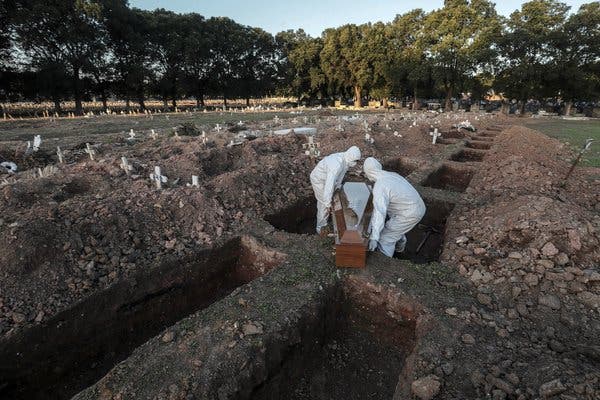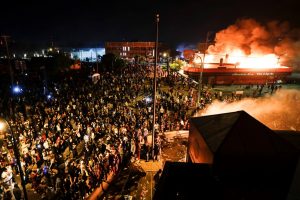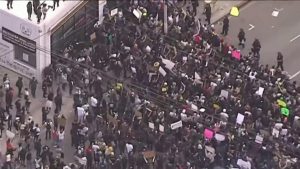Here’s what you need to know:
- The U.S. has sent two million doses of hydroxychloroquine to Brazil.
- Will protests spark a second viral wave?
- Two parallel plagues are ravaging America: the coronavirus and police violence.
- Nicaragua has resisted imposing lockdown rules. Now the virus appears to be raging through the country.
- Congregations emerge from quarantine to celebrate the Pentecost and to call for change.
The U.S. has sent two million doses of hydroxychloroquine to Brazil.
The United States has delivered two million doses of a malaria drug to Brazil for use in the fight against the coronavirus pandemic, and the two countries are embarking on a joint research effort to study whether the drug is safe and effective for the prevention and early treatment of Covid-19, the White House announced Sunday.
The White House announcement comes after months of controversy over the drug, hydroxychloroquine, which President Trump has aggressively promoted, despite a lack of scientific evidence of its effectiveness as a treatment for Covid-19. Mr. Trump stunned public health experts recently by saying he was taking a two-week course of the medicine.
The donated doses will be used as a prophylactic “to help defend” Brazil’s nurses, doctors and health care professionals against infection, and will also be used as a therapeutic to treat Brazilians who become infected, the White House said.
Hydroxychloroquine is widely used for the prevention of malaria and for treatment of certain autoimmune diseases including rheumatoid arthritis and lupus, and many doctors consider it safe. But the Food and Drug Administration has warned that it can cause heart arrhythmias in some patients, and the debate over its use in the coronavirus pandemic has been politically fraught.
Early research in Brazil and New York suggested that it could be linked to a higher number of deaths among hospitalized patients. More recently, a review of a hospital database published by the influential medical journal, The Lancet, concluded that treating people who have Covid-19 with chloroquine and hydroxychloroquine did not help and might have increased the risk of abnormal heart rhythms and death.
But last week, more than 100 scientists and clinicians questioned the authenticity of that database. Some researchers say hydroxychloroquine does show promise as a possible prophylactic or treatment in the early stages of Covid-19, and a number of clinical trials — including one conducted by the National Institute for Allergy and Infectious Diseases — are trying to answer those questions. Amid the uproar, experts say, legitimate research has suffered.
Will protests spark a second viral wave?
Mass protests against police brutality that have brought thousands of people out of their homes and onto the streets in cities across America are raising the specter of new coronavirus outbreaks, prompting political leaders, physicians and public health experts to warn that the crowds could cause a surge in cases.
While many political leaders affirmed the right of protesters to express themselves, they urged the demonstrators to wear face masks and maintain social distancing, both to protect themselves and to prevent further community spread of the virus.
More than 100,000 Americans have already died of Covid-19, the disease caused by the new coronavirus. People of color have been particularly hard hit, with rates of hospitalizations and deaths among black Americans far exceeding those of whites.
Some infectious disease experts were reassured by the fact that the protests were held outdoors, saying the open air settings could mitigate the risk of transmission. In addition, many of the demonstrators were wearing masks, and in some places, they appeared to be avoiding clustering too closely.
“The outdoor air dilutes the virus and reduces the infectious dose that might be out there, and if there are breezes blowing, that further dilutes the virus in the air,” said Dr. William Schaffner, an infectious disease expert at Vanderbilt University. “There was literally a lot of running around, which means they’re exhaling more profoundly, but also passing each other very quickly.”
Two parallel plagues are ravaging America: the coronavirus and police violence.
Jimmy Mills’s barbershop in Midtown Minneapolis was one of many small, black-owned businesses that have struggled to survive the pandemic. But Mr. Mills was hopeful because, after two months of shut down, he was set to reopen next week.
Then early on Friday, the working-class neighborhood where Mr. Mills has cut hair for 12 years went up in flames as chaotic protests over the death of George Floyd and police killings of African-Americans engulfed Minneapolis and cities across the country.
“To have corona, and then this — it’s like a gut shot,” Mr. Mills, 56, said.
With more than 200 businesses damaged or destroyed in the unrest, Mr. Noor said he was worried about new waves of foreclosures, job losses and business failures.
“Many people who are poor who didn’t have much, this devastation will really impact them,” Mr. Noor said.
Even before the pandemic, the Midtown neighborhood, where buildings were burned, damaged and looted, had been trying to rebuild itself after years of economic hardship. The area is in a historically segregated part of town where some residents had felt neglected. A railway was repurposed into a bike and walking trail that runs through the neighborhood. The Midtown Global Market had sprung up, attracting diners and shoppers to its Hmong, Indian, Moroccan and other international food and crafts.
But now, next door to Mr. Mills, the barber, a dollar store and beauty-supply shop have been burned to rubble. The front windows of Mr. Mills’s barbershop were smashed, and looters stole his televisions, video equipment and his clippers.
With the power out, water seeping across the floor and phalanxes of police officers and National Guard troops blockading his neighborhood, he does not know when his J-Klips barbershop might reopen.
Nicaragua has resisted imposing lockdown rules. Now the virus appears to be raging through the country.
Nicaragua is one of the last countries to resist adopting strict measures to curb the spread of the virus. It never closed its schools. It did not shutter businesses. Throughout the pandemic, the government not only allowed mass events — it organized them.
Now there are signs everywhere that the virus is raging across the country, though the government insists it has the situation under control.
Long lines have formed at hospitals, and pharmacies have run out of basic medicines. Families of people who die of respiratory illnesses are being forced to hold “express burials” at all hours of the night, for fear of contagion.
Health organizations are struggling to get accurate case numbers. Testing is limited and controlled by the government. Doctors and activists are bracing for disaster, just two years after antigovernment uprisings against President Daniel Ortega turned violent.
Facing withering criticism, the government released a report last Monday stating that critics were trying to sow chaos, and that the vast majority of people in the country, the second-poorest in the hemisphere, could not afford to lose work under a strict lockdown.
Elena Cano said her 46-year-old son, Camilo Meléndez, the facilities manager at the National Assembly building, died on May 19 from “unusual severe pneumonia,” after trying to get medical care several times.
“The whole world has to understand the truth of the crime that our government is committing,” she said.
Congregations emerge from quarantine to celebrate the Pentecost and to call for change.
In communities from the Deep South to California, congregations that had been sequestered for months ventured forth at a social distance on Sunday in search of comfort, prayer and political expression.
With their sick and elderly at home and their nation wracked by the pandemic, evangelical congregations across California violated state health rules in the name of unity.
“Outside the confines of these walls we hear the sound of a very broken world,” Samuel Rodriguez, the pastor of New Season Christian Worship Center in Sacramento, said.
At least a dozen evangelical churches in California made a coordinated return to church timed to Pentecost, a holy day particularly tied to fundamentalist worship. Some in that group were also seeking to pressure the state’s Democratic governor, Gavin Newsom, into dropping a 100-person cap on church attendance that the state had enacted to curb the spread of the disease.
Supporters acknowledged the legal and health risks, but said their congregants’ spiritual health would suffer if they delayed their return to public worship.
“It’s been terrible, an unimaginable tide of grief,” said the Rev. W. Franklyn Richardson, the senior pastor at Grace Baptist Church in Mount Vernon, N.Y., said of the moment. Mr. Richardson, who is African-American, noted that during the worst of the pandemic, he was making three to five condolence calls a day.
Still, he said, the church has not, and cannot, abdicate its central role in pushing for positive change. “I think the church has to help make sure it is a wake up call,” he said of the unrest. “The church has had to be a safety net for a society that has ignored the community.”
Reporting was contributed by Roni Caryn Rabin, Raphael Minder, Jack Healy, Dionne Searcey, Stacy Cowley, Antonio de Luca, Rick Rojas, Dave Taft and Umi Syam.




















